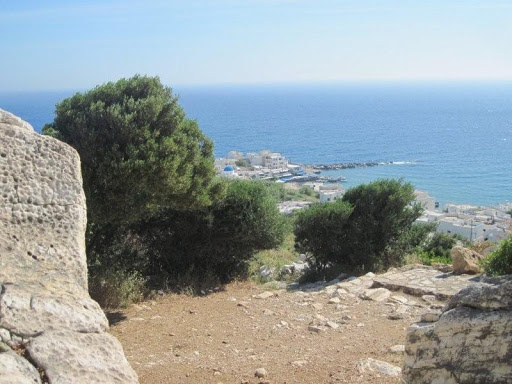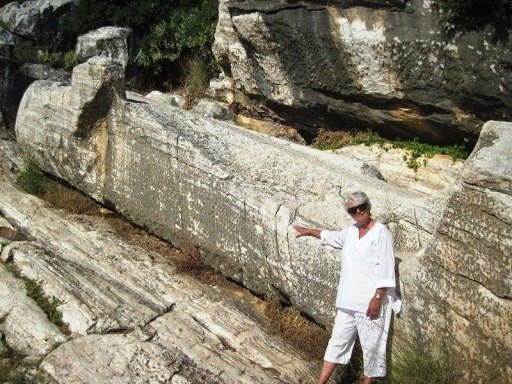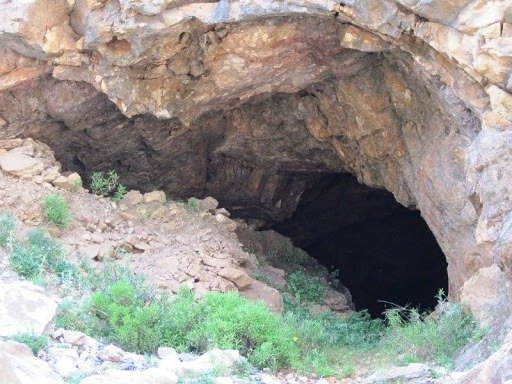Present day visitors to Naxos while enjoying the scenery, the beaches and hospitality of the people have been moved to exclaim, “This is a land blessed by the gods!” Well, according to ancient Greek myths they are right.
Zeus, the ruler of the Olympian gods, was born on Crete but raised on Naxos. While there he fathered Dionysus through a process of surrogate motherhood. Thus Dionysus as the god of wine as well as of ritual madness and ecstasy favored the island with fertility and lushness. It thrived throughout the archaic period resulting in many temples and sanctuaries as well as contributions to the treasuries of Delphi and Delos. For details of the ancient history of Naxos see the excellent article on the Ancient History site.

Major Sites
The most ancient of Naxos antiquities were found at what is now the square in front of the Greek Orthodox cathedral. This area known as Grotta is better known for its hotels and beach but does hold an in situ museum in three levels representing the major stages of Mycenaean, Roman and early Christian towns spread over 3,500 years. Also note the use of ancient materials in building the church. Even more of the ancient town can be found under water.

The most visible and accessible of Naxos antiquities is up front and in your face as soon as you enter the harbor. It is unique in that rather being the ruins of a once grand structure it is the abandoned remains of an uncompleted project. About 530 B.C. when Naxos was rich and powerful its ruler decided to build the greatest and tallest temple in Greece and hence the world (how little human nature of rulers has changed). Soon, however, he was at war with neighboring Samos which stopped construction and then he was overthrown and his successors abandoned

The most extensive of the Naxos antiquities is the Temple of Demeter near Sangri. On my first trip there I was reminded of numerous movies I had seen as a child where a group of intrepid explorers hacked their way through the jungle to suddenly see a vista of a ruined ancient city. On Naxos we drove our scooters along winding back country roads lined with ordinary farms and fields to suddenly be exposed to an awesome vista of extensive ancient ruins of the temple and other buildings. For you it will be easy to find with a good map and watching for the brown signs.
As the goddess of harvests and earth fertility temples to Demeter are usually located in fertile growing areas and that is the case here. The current archeological grounds are quite extensive with good explanatory materials in English. Although most of the original marble was looted and scattered over the centuries extensive reconstruction was accomplished in the 1990s by a German archeological group. This temple also dates from the Naxos high point of 6th century B.C.
Finally we relate to the introductory paragraph with a trip to the temples of Dionysus. These were started as early as the 9th century B.C. and expanded and modified at least five times before being torn down by the Christians. The latest ancient version from the 6th century B.C. has been reconstructed. The site is extensive; showing several early architectural elements and how they developed over time at the site. Also excavated and displayed are many of the offerings to Dionysus. Early Greeks believed he lived among the dense woods and plentiful vineyards of the ever lush Naxos. This archeological area known as Iria is found not far inland from the attractive beach village of Ag. Anna.
Kouros
Naxos is especially noted for its kouros, ancient statues of young men. The two most important are at the ancient marble quarries near Melanes and the resort village of Apollona. These are dated from the 6th and 7th centuries B.C. and thought to be abandoned due to flaws.The smaller kouros at Melanes is obviously meant to show the god Apollo because of its long hair. In early Greece only Apollo was allowed to grow long hair.

Mycenean Tombs
In the Eggares region it is possible to visit the remains of Mycenaean tombs, but we have not done so yet. Anybody who has is welcome to contribute to this article.
Zeus
On Naxos we especially enjoy riding through the mountains being impressed by their size and ruggedness and the tremendous vistas. The tallest mountain on the island is Mount Zeus. Within it lies the Cave of Za (Zeus) just outside the town of Filoti. Prehistoric remains have been found in and around the cave and local myth claims it is where Zeus lived while on Naxos.
Other
While we are on the subject of driving around the island we will mention a couple spots that are not ancient but are worth visiting while you are out and about.
At the south end are Chimarro’s Tower and Kalantos Beach. The former was supposedly built in the 4th century for advance warning of pirate raids. It has been preserved and partially rebuilt. The beach is long, sandy and has shade trees but food and drink are only available during busy times which are very rare.
As on Paros in the middle of Naxos is a castle built with stones that were carved in the classical period. This is Apano Castle which is reached from trails between the village of Potamia and Tsilikario. It is in the wall on the southwest slope that you can see these large rectangular blocks. On the northeastern side of the castle is a cemetery from the 9th Century B.C. that includes a monolith three meters high.

Finally, we found the emery mining on Naxos to be fascinating. This is another example like the marble mines of Paros where in visiting a site one cannot tell what is current, what is historical and what is ancient. The emery mining on Naxos has been more or less continuous for over 2,000 years. For many years, including WW II, it was the western world’s primary source.
Older readers would have heard of emery boards and emery clothes for polishing but may not realize their use started in ancient Greece. The name comes from the eastern peninsula of Naxos, Emeri. However, in ancient times it was called smyris because it was distributed out of the port of Smyrna.
How to get there
Naxos is on the main ferry route out of Piraeus as well as Rafina and Mykonos. It is a good base for trips to Delos as well as Santorini.
Flights go direct to Santorini and Mykonos from the UK, usually from Gatwick and some regional airports. Also there are flights to and from Athens.
Learn more about non-ancient Naxos and nearby islands on this personalised travel guide: www.ParosParadise.com
Getting around the island
In addition to the ancient sites this island has long sandy beaches on the West side and interesting isolated villages on the East. Due to its large size and mountains it takes longer to travel from place to place but the visits are well worth it.
There is bus service among the towns and villages but to see most sites you will need to hire a car or scooters–or be an experienced hiker.